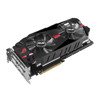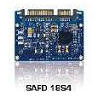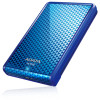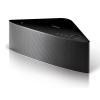This chip is presented by ATI RADEON 7500 (290 MHz) 64MB, AGP videocard.
Features:
- ATI RADEON 7500 chip, 290MHz clock rate;
- 64MB DDR SDRAM memory in eight ESMT 4ns microchips, 230 (460) MHz clock rate, 128-bit bus;
- Peak fill rate in the multitexturing mode is 580 megapixels/sec and 1740 megatexels/sec with three texture blocks on each pipeline and 1160 megatexels/sec with two texture blocks on each pipeline.
Overclocks to 320/270 (540) MHz (see summary diagrams).
As I wrote in the review of this card, ATI has at last released not only the fastest card to compete with the NVIDIA GeForce3 leader, but has also released a middle level card for competing with its NVIDIA GeForce2 Pro and GeForce2 Ti analogues - RADEON 7500. Per se it's the same RADEON but produced according to thinner 0.15 micron technical process and thus capable of working at phenomenal clock rate of 290 MHz (and even higher). ATI provided this chip with fast 4ns memory and really succeeded in making a competitor for middle level accelerators. But there are some disappointments. First, only ATI's cards have chips clocked at 290 MHz, but they cost high and almost can't compete with prices for GeForce2 Ti. Second, ATI has lowered clock rate "on the sly" again without notifying users. So we've made a separate section for RADEON 7500 cards, manufactured by ATI partners. Now we see that RADEON 7500 actually sentenced all previous RADEON cards. But now RADEON 7500 itself is threatened by RADEON 9000, providing DX81 technologies to the Low-End.
On the 10th of August 2002 the latest drivers from ATI are 6.102, 6.107, 6.118 for Windows XP.
I shall note there's
Radeon2.ru web-site that tracks all software novelties from ATI and offers improved drivers versions with preset registry settings for increasing RADEON cards perfomance.
As you can see, the latest Windows XP drivers are rather good. Some versions demonstrated problems with refresh rate setting. Known treatments are described at Radeon2.ru. You can also read about problems users of various ATI cards face with various drivers.
And now I want to attract your attention to another important 3D feature - filtering. As many of you know, all chipsets support bilinear filtering that is an important instrument in MIP-mapping, some chipsets support trilinear filtering (true, not the approximation) and only few support anisotropic filtering.
Due to the fact that Radeon does support anisotropic filtering, I recommend you to pay attention to the article concerning this feature.
Below are some screenshots taken on RADEON and reference ones taken on NVIDIA GeForce3.
| Games / Cards |
1 |
2 |
3 |
4 |
5 |
6 |
7 |
8 |
9 |
10 |
11 |
12 |
| ATI RADEON 7500 |


|
- |


|


|


|


|


|


|


|


|


|


|
| NVIDIA GeForce3 |


|




|


|


|


|


|


|


|


|


|


|


|
| Games / Cards |
13 |
14 |
15 |
16 |
17 |
18 |
19 |
20 |
21 |
22 |
23 |
24 |
| ATI RADEON 7500 |


|


|


|


|


|
- |

|

|

|
- |


|


|
| NVIDIA GeForce3 |


|


|


|


|


|


|

|

|

|

|


|


|
| Games / Cards |
25 |
26 |
27 |
28 |
29 |
30 |
| ATI RADEON 7500 |


|


|


|


|


|


|
| NVIDIA GeForce3 |


|


|


|


|


|


|
|
Game list:
- 1. Return to Castle Wolfenstein
- 2. Unreal2 (alpha version)
- 3. Comanche4
- 4. Jedi Knight II Outcast
- 5. Morrowind
- 6. Colin McRAE Rally2 (Windows XP)
- 7. Red Faction
- 8. Rally Trophy
- 9. Sacrifice
- 10. Venom
- 11. Unreal Tournament 2003 DEMO
- 12. Real MYST
- 13. Blade of Darkness (Windows XP)
- 14. Neverwinter Nights
- 15. 3DMark2001: Game1
- 16. 3DMark2001: Game2
- 17. 3DMark2001: Game3
- 18. 3DMark2001: Game4
- 19. 3DMark2001: Dot3
- 20. 3DMark2001: EMBM
- 21. 3DMark2001: Vertex Shaders
- 22. 3DMark2001: Pixel Shaders
- 23. Warcraft III
- 24. Soldier of Fortune II
- 25. Command and Conquer: Renegade
- 26. Max Payne
- 27. AquaNox
- 28. Serious Sam: The Second Encounter
- 29. IL2: Shturmovik
- 30. MoHAA
|
|





















